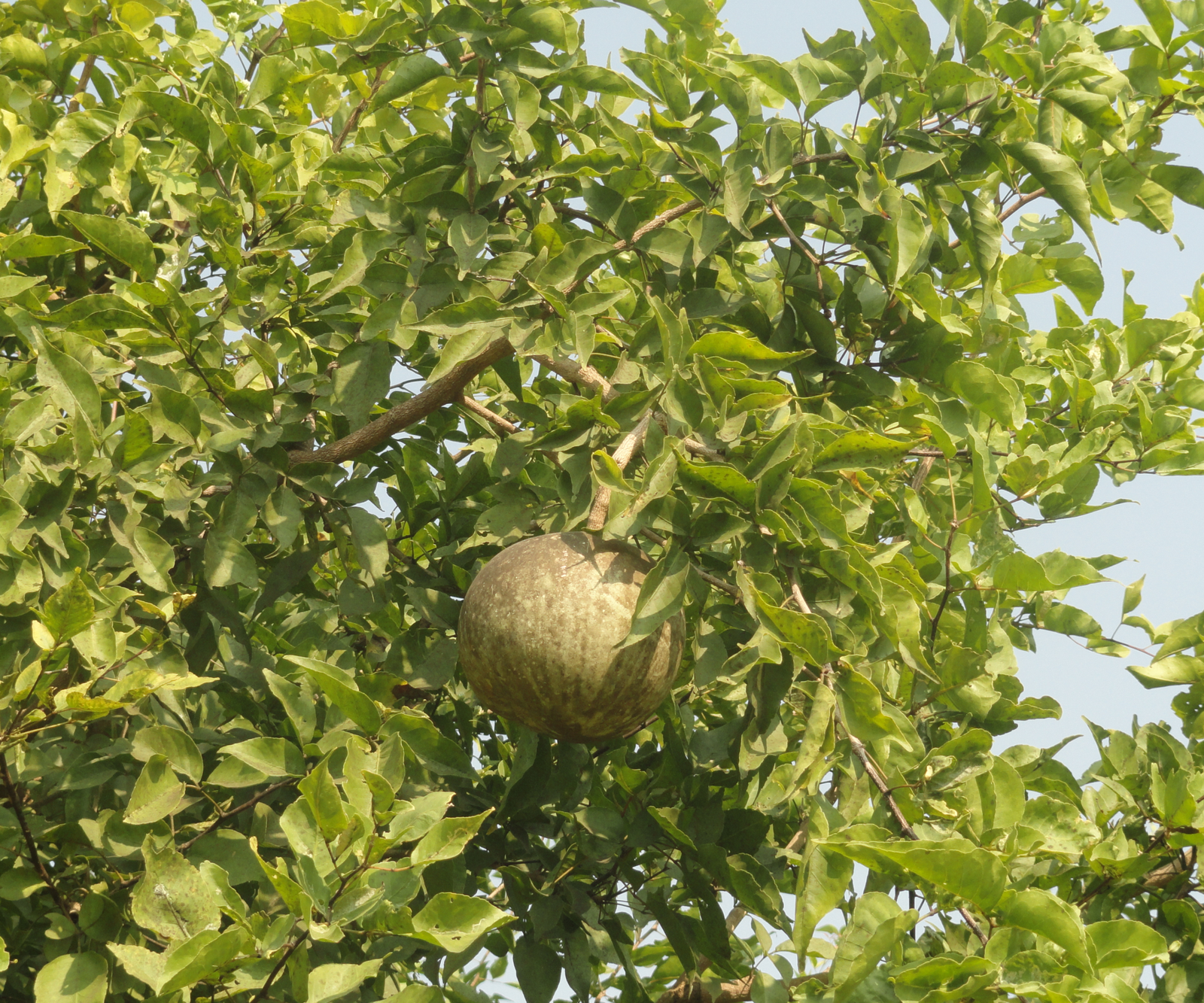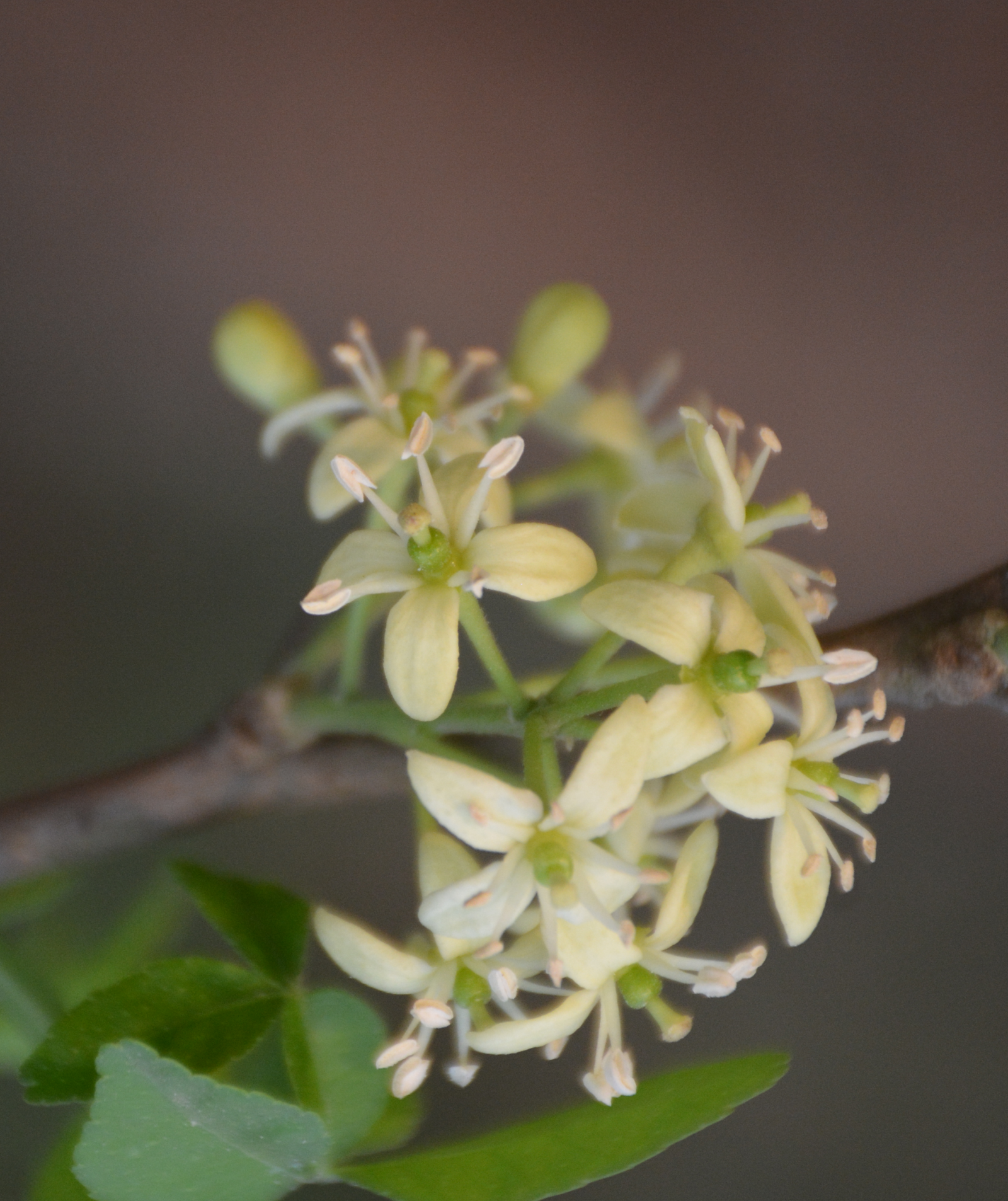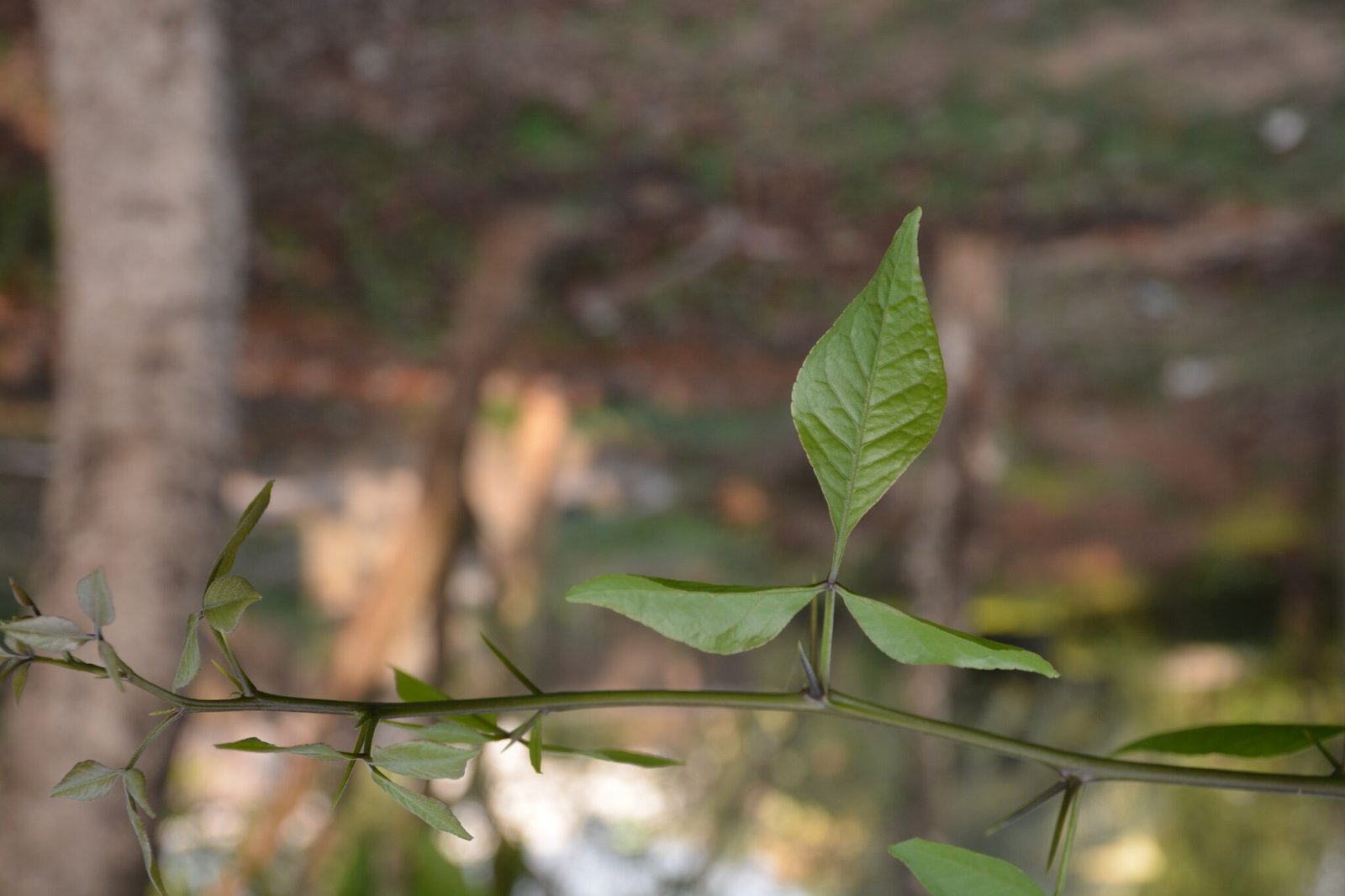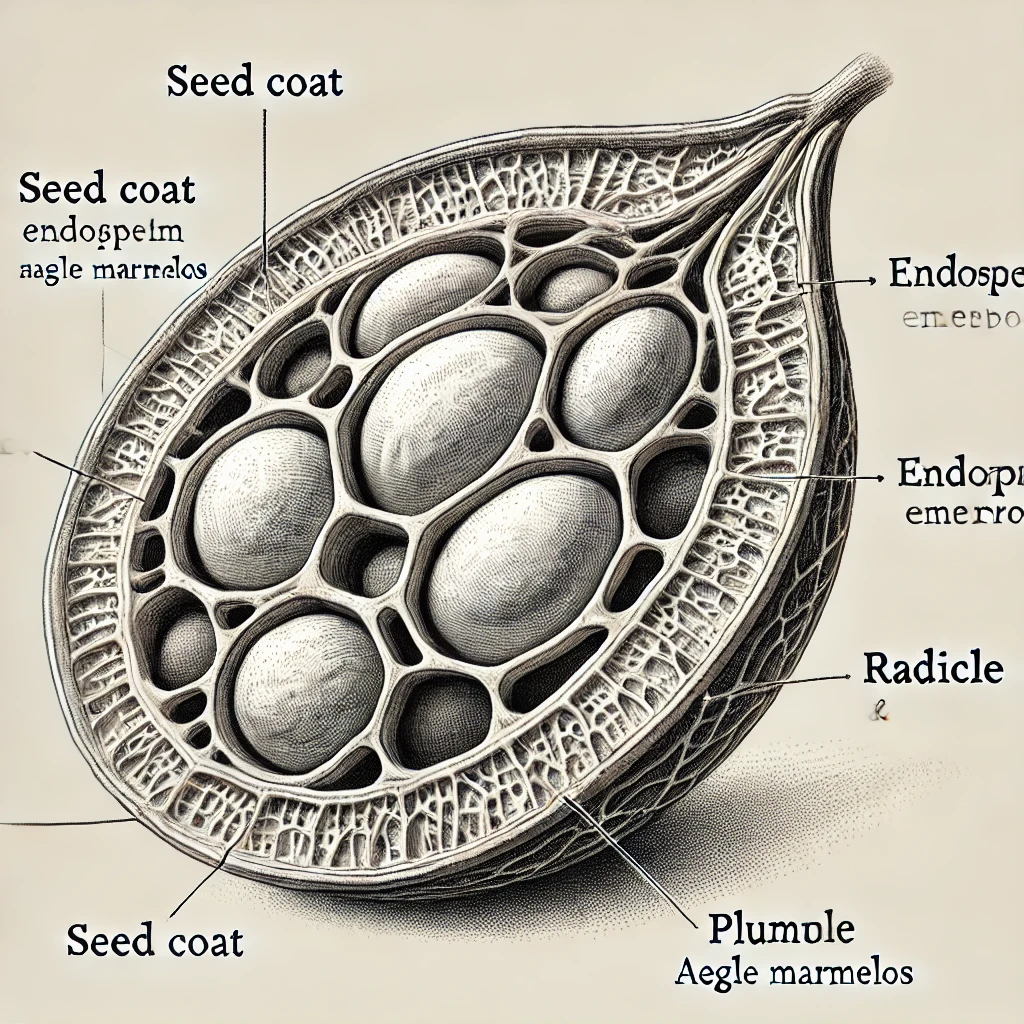Aegle marmelos: The Silent Guardian of Semi-Arid Land
Introduction:
Meet Aegle marmelos, or as it’s more commonly known, the Bael tree, Bel tree (in bengali: “বেল”)—a true survivor in the plant kingdom. This hardy, drought-tolerant tree has been a cornerstone of Indian culture, medicine, and ecology for centuries. Thriving in the semi-arid and tropical regions of the Indian subcontinent, Bael is a testament to nature’s resilience, growing in poor soils and requiring little water to flourish. It’s no wonder this tree has become a go-to choice for reforestation and agroforestry, especially in areas where the land has been stripped of its vitality.
But Bael is more than just a tough tree. It’s a cultural icon, deeply woven into the fabric of Indian traditions. Revered for its medicinal properties, almost every part of the Bael tree—its leaves, fruit, bark, and roots—has been used in Ayurveda and other traditional healing practices for generations. From soothing digestive troubles to treating respiratory issues and skin conditions, Bael has been a trusted natural remedy for centuries. And let’s not forget its fruit—a nutritional powerhouse that’s enjoyed fresh or transformed into refreshing drinks, jams, and sweets.
Ecologically, Bael is a bit of a superhero. Its fragrant flowers attract pollinators, while its fruit provides a feast for wildlife, helping to sustain local ecosystems. Its deep roots dig into the earth, holding soil in place and preventing erosion, making it a natural ally in the fight against desertification and land degradation.
Yet, despite its many gifts, Bael faces growing threats. Climate change, deforestation, and the decline of medicinal plant populations are putting pressure on this remarkable species. That’s why conserving and sustainably utilizing Bael has never been more critical. By protecting and promoting this tree, we’re not just preserving a piece of natural heritage—we’re also supporting local communities and paving the way for a more sustainable future.
In this exploration, we’ll dive into the ecological, cultural, and medicinal wonders of the Bael tree, uncovering why it’s such a vital player in the fight against environmental challenges and a beacon of hope for sustainable living.
Etymology:
The name Aegle marmelos carries a rich linguistic and historical background, reflecting its cultural and botanical significance. The genus name Aegle is derived from Greek mythology, where Aegle was one of the Hesperides, nymphs tasked with tending to divine orchards that bore golden apples. This mythological connection underscores the sacred and medicinal importance of the Bael tree in ancient traditions, symbolizing its revered status as a source of healing and nourishment.
The species name marmelos is believed to have originated from the Portuguese word “marmelo,” meaning quince. This naming likely stems from the resemblance between the Bael fruit and the quince fruit (Cydonia oblonga), particularly in their hard, woody shells and aromatic pulp. The Portuguese influence on the naming reflects the historical interactions between European traders and the Indian subcontinent, where Bael has been a prominent species for centuries.
In Sanskrit, the Bael tree is known as Bilva / बिल्व, a term deeply rooted in ancient Hindu scriptures such as the Vedas and Puranas. In these texts, Bilva is closely associated with Lord Shiva and is considered sacred. The leaves of the Bael tree are often offered in Shiva worship, symbolizing purity and devotion. This spiritual connection further highlights the tree’s enduring cultural and religious significance in Indian traditions.
Together, the etymology of Aegle marmelos weaves a fascinating narrative, blending mythology, linguistics, and cultural heritage, and reflecting the tree’s multifaceted role in human history.
Botanical Description:
Taxonomic Classification:
The Bael tree, scientifically known as Aegle marmelos (L.) Corrêa, belongs to the following taxonomic hierarchy:
- Kingdom: Plantae (Plants)
- Clade: Tracheophytes (Vascular plants)
- Clade: Angiosperms (Flowering plants)
- Clade: Eudicots (True dicotyledons)
- Order: Sapindales (Soapberry order)
- Family: Rutaceae (Rue or Citrus family)
- Genus: Aegle
- Species: Aegle marmelos
- Genus: Aegle
- Family: Rutaceae (Rue or Citrus family)
- Order: Sapindales (Soapberry order)
- Clade: Eudicots (True dicotyledons)
- Clade: Angiosperms (Flowering plants)
- Clade: Tracheophytes (Vascular plants)
This classification places Bael in the same family as citrus fruits, highlighting its botanical kinship with plants like oranges and lemons.
Morphological Characteristics:
The Bael tree is a fascinating specimen, with distinct features that make it easily recognizable and ecologically significant. Here’s a closer look at its morphology:
- Tree: A medium-sized, deciduous tree, Bael typically grows to a height of 10–15 meters. It boasts a spreading crownwith branches that extend outward, creating a canopy that provides shade and shelter.
- Bark: The bark is corky, grayish-brown, and deeply fissured. This rugged texture not only gives the tree a distinctive appearance but also serves as a protective layer against harsh weather conditions, such as extreme heat or drought.
- Leaves: The leaves are trifoliate, meaning each leaf is divided into three leaflets. They are aromaticand glossy green, with a unique antibacterial property that has been utilized in traditional medicine for centuries.
- Flowers: Bael flowers are small, greenish-white, and highly fragrant. They grow in clusters, attracting a variety of pollinators, including bees and insects, which play a crucial role in the tree’s reproduction.
- Fruit: The fruit of the Bael tree is globular, measuring 5–12 cm in diameter. It has a hard, woody shellthat protects the soft, aromatic pulp inside. The pulp is mucilaginous (slimy) and is prized for its nutritional and medicinal value.
- Seeds: Inside the fruit, the seeds are small, oblong, and embedded within the pulp. Each seed is encased in a fibrous protective coat, which aids in its dispersal and survival.
Together, these morphological traits make the Bael tree not only a resilient species but also a valuable resource for ecological, medicinal, and cultural purposes. Its unique characteristics have earned it a special place in both natural ecosystems and human traditions.
Spermology of Aegle marmelos:
Understanding the morphology, viability, and germination of Bael seeds is essential for effective propagation and conservation of this valuable species. Here’s a detailed look at the key aspects of Bael seeds:
Seed Structure:
- Shape: Bael seeds are oblong to ovalin shape.
- Size: They are relatively small, measuring approximately 1–1.5 cm in length.
- Seed Coat: The seed coat is hard, fibrous, and slightly wrinkled, which contributes to its dormancy by preventing immediate water absorption.
- Endosperm: Inside the seed, the endosperm is fleshy and mucilaginous, rich in carbohydrates that provide nourishment to the developing embryo.
- Embryo: The embryo is small and centrally locatedwithin the endosperm, ready to grow into a new plant under favorable conditions.
Seed characteristics:
- Seed Count: There are approximately 10,000–15,000 seeds per kilogram, making them relatively lightweight and abundant.
- Dormancy: Bael seeds exhibit physiological dormancy, primarily due to their hard seed coat, which delays germination until conditions are optimal.
- Germination Type: The germination process is epigeal, meaning the seedlings emerge above the ground, with the cotyledons (seed leaves) becoming the first photosynthetic organs.
Seed Viability & Storage:
- Viability: Fresh Bael seeds have a viability rate of 30–50%, but this decreases rapidly after six months if not stored properly.
- Storage Conditions: To maintain viability, seeds should be stored in cool, dry places, away from moisture and extreme temperatures.
- Dormancy Breaking: To overcome dormancy, seeds often require scarification(scratching or weakening the seed coat) or soaking in warm water for 24–48 hours to soften the hard outer layer and initiate germination.
Illustration of Bael Seed Structure:
- The outermost layer is the hard, fibrous seed coat, which protects the inner components.
- Beneath the seed coat lies the fleshy endosperm, which surrounds the small, centrally located embryo.
- The embryo consists of the radicle(future root), plumule (future shoot), and cotyledons (seed leaves), which play a vital role in the early growth of the seedling.
Understanding these seed characteristics is critical for successful cultivation and propagation of Bael trees, ensuring their continued role in ecological restoration, traditional medicine, and sustainable agriculture.
Propagation and Nursery Techniques:
Effective propagation and nursery management are essential for cultivating healthy Bael trees, whether for ecological restoration, agroforestry, or medicinal purposes. Below is a detailed guide to the techniques and conditions required for successful propagation.
Seed Collection & Viability:
- Optimal Harvesting Time: Seeds should be collected during the summer months, when the fruits turn yellow-orange and are fully mature (Erkan, M., & Dogan, A. (2019)).
- Seed Germination Rate: Under optimal conditions, Bael seeds exhibit a germination rate of 40–60% (Bohra, N. K., Manda, M., Katariya, A. K., & Yadav, P. (2024)).
- Pre-Treatment: To enhance germination, seeds often require pre-treatment methods such as:
- Scarification: Scratching or weakening the hard seed coat to allow water absorption (Kumar, M., Sarvade, S., Kumar, R., & Kumar, A. (2024)).
- Soaking in Hot Water: Immersing seeds in water at 50°C for 30 minutes to soften the seed coat (Kumar, M., Sarvade, S., Kumar, R., & Kumar, A. (2024).).
- Chemical Treatment: Using gibberellic acid (GA3) at 500 ppm to break dormancy and stimulate germination (Sharma, A., Mahawer, A. K., & Meena, L. K. (2024)).
Germination & Nursery Management:
- Temperature: The optimal temperature range for germination is 25–35°C(Venudevan, B., Srimathi, P., Natarajan, N., & Vijayakumar, R. M. (2013)).
- Humidity: Bael seeds prefer a relative humidity of 60–80% for successful germination (Singh, A. K., Singh, S., Saroj, P. L., & Singh, G. P. (2021)).
- Soil Preference: A sandy loam soil that is well-drained and rich in organic matter is ideal for seedling growth (Warkentin, B. P. (1984).)
- Germination Time: Under controlled conditions, seeds typically germinate within 10–25 days(Singh, A. K., Singh, S., Saroj, P. L., & Singh, G. P. (2021).).
- Watering Regime: Moderate watering is recommended, ensuring the soil remains moist but avoiding waterlogging, which can harm the seedlings (Kaur, G., Singh, G., Motavalli, P. P., Nelson, K. A., Orlowski, J. M., & Golden, B. R. (2020)).
- Transplanting: Seedlings are ready to be transferred to the field at 4–6 months of age, when they are robust enough to withstand outdoor conditions.
Vegetative Propagation:
For those seeking to propagate Bael trees while maintaining genetic purity or accelerating fruiting, vegetative propagation methods are highly effective:
- Air Layering: This method involves inducing roots on a stem while it is still attached to the parent plant. It has a 90% success rate under controlled humidity conditions (Singh, A. K., Singh, S., Saroj, P. L., & Singh, G. P. (2021).).
- Grafting: Grafting is commonly used to ensure genetic purity and promote early fruiting. It involves joining a Bael scion (young shoot) to a rootstock of a related species (Ghosh, S. N., Roy, S., & Bera, B. (2012).).
- Stem Cuttings: Stem cuttings can be used for propagation but require hormone treatments such as Indole-3-butyric acid (IBA) at 2000 ppm to induce root formation (N.B. research needs to be conducted on this for validating the statement).
Traditional & Medicinal Uses:



Aegle marmelos holds a revered place in traditional medicine systems such as Ayurveda, Unani, and Siddha, where it has been used for centuries to treat a wide range of ailments. Its therapeutic properties are well-documented, and almost every part of the tree—fruit, leaves, bark, and roots—has medicinal value.
Ayurvedic Uses:
- Fruit: The fruit of the Bael tree is widely used to treat gastrointestinal disorders such as diarrhea, dysentery, and constipation. Its high fiber content and antimicrobial properties make it effective in regulating digestion.
- Leaves: Bael leaves are known for their role in diabetes management and treating liver disorders. They contain compounds that help regulate blood sugar levels and improve liver function.
- Root Bark: The root bark is used as an anti-inflammatory and analgesic agent, providing relief from pain and swelling in conditions like arthritis.
Unani Medicine:
- Decoctions: Bael decoctions are commonly used to treat respiratory ailments such as asthma, bronchitis, and coughs. The decoction helps clear mucus and soothe the respiratory tract (Jagetia, G. C. (2023)).
- Oil Extracts: Oil extracted from Bael leaves and fruit is applied topically to treat skin infections, wounds, and ulcers. Its antimicrobial and wound-healing properties promote faster recovery (Mahomoodally Mohamad Fawzi et al ).
Siddha Medicine:
- Bael Extracts: In Siddha medicine, Bael extracts are used to purify blood and enhance digestion. The fruit pulp is particularly valued for its ability to detoxify the body and improve overall health (Baliga, M. S., Bhat, H. P., Joseph, N., & Fazal, F. (2011)).
- Pulp Paste: A paste made from the fruit pulp is applied externally to treat ulcers and skin inflammations. Its cooling and healing properties make it effective in soothing irritated skin (Jagetia, G. C. (2023)).
Challenges and Conservation Efforts:
The conservation of Aegle marmelos is critical due to its ecological, medicinal, and cultural significance. However, the species faces several challenges that threaten its survival. Addressing these issues requires a combination of strategic conservation efforts and community involvement.
Major Challenges:
- Overharvesting: Excessive extraction of fruits and barkfor medicinal and commercial purposes has led to a decline in natural Bael populations. Overharvesting disrupts the tree’s reproductive cycle and reduces its ability to regenerate (Singh, A., & Chaurasiya, A. K. (2014)).
- Low Germination Rate: Bael seeds exhibit physiological dormancy due to their hard seed coat, which delays germination. Additionally, fungal infections during storage or planting further reduce germination rates (Govind, Kumar, M., Kumar, M., & Hardeep. (2024)).
- Habitat Destruction: Deforestation and land-use changes for agriculture and urbanization have significantly reduced the natural habitats of Bael trees, threatening their survival (Waheed, M., Haq, S. M., Arshad, F., Jameel, M. A., Siddiqui, M. H., Bussmann, R. W., … & Alamri, S. (2023).).
Conservation Strategies:
- Seed Banks: Establishing seed banks to preserve the genetic diversity of Bael is a crucial step in conservation. Storing seeds under controlled conditions ensures their availability for future propagation and research (Wambugu, P. W., Nyamongo, D. O., & Kirwa, E. C. (2023)).
- Agroforestry Integration: Integrating Bael trees into agroforestry systems can promote sustainable cultivation. Growing Bael alongside crops not only conserves the species but also enhances soil fertility and biodiversity (Kumar, R., Singh, S., & Sharma, A. (2024)).
- Community Participation: Engaging local communities through awareness programs and training on sustainable harvesting practices is essential. Empowering communities to protect and sustainably use Bael resources can significantly aid conservation efforts (Girma, A., Teketay, D., Bekele, T., & Gole, T. W. (2024)).
Conclusion:
Aegle marmelos, or the Bael tree, stands as a pillar of ecological balance, medicinal advancement, and cultural heritage. Its remarkable ability to thrive in harsh climatic conditions and poor soils makes it a symbol of resilience, particularly for semi-arid and degraded landscapes. Beyond its environmental contributions, Bael has been a cornerstone of traditional medicine systems like Ayurveda, Unani, and Siddha, offering remedies for a wide range of ailments and improving the well-being of countless communities.
However, the survival of this invaluable species is under threat due to overharvesting, habitat destruction, and low germination rates. Addressing these challenges requires a multifaceted approach, including sustainable cultivation practices, scientific propagation techniques, and robust conservation initiatives. By integrating Bael into agroforestry systems, establishing seed banks, and fostering community participation, we can ensure the preservation of this species for future generations.
The conservation of Aegle marmelos is not just about protecting a tree—it is about safeguarding a legacy of ecological resilience, medicinal wisdom, and cultural significance. Through collective efforts, we can secure the future of this remarkable species, ensuring it continues to benefit both people and the planet.

